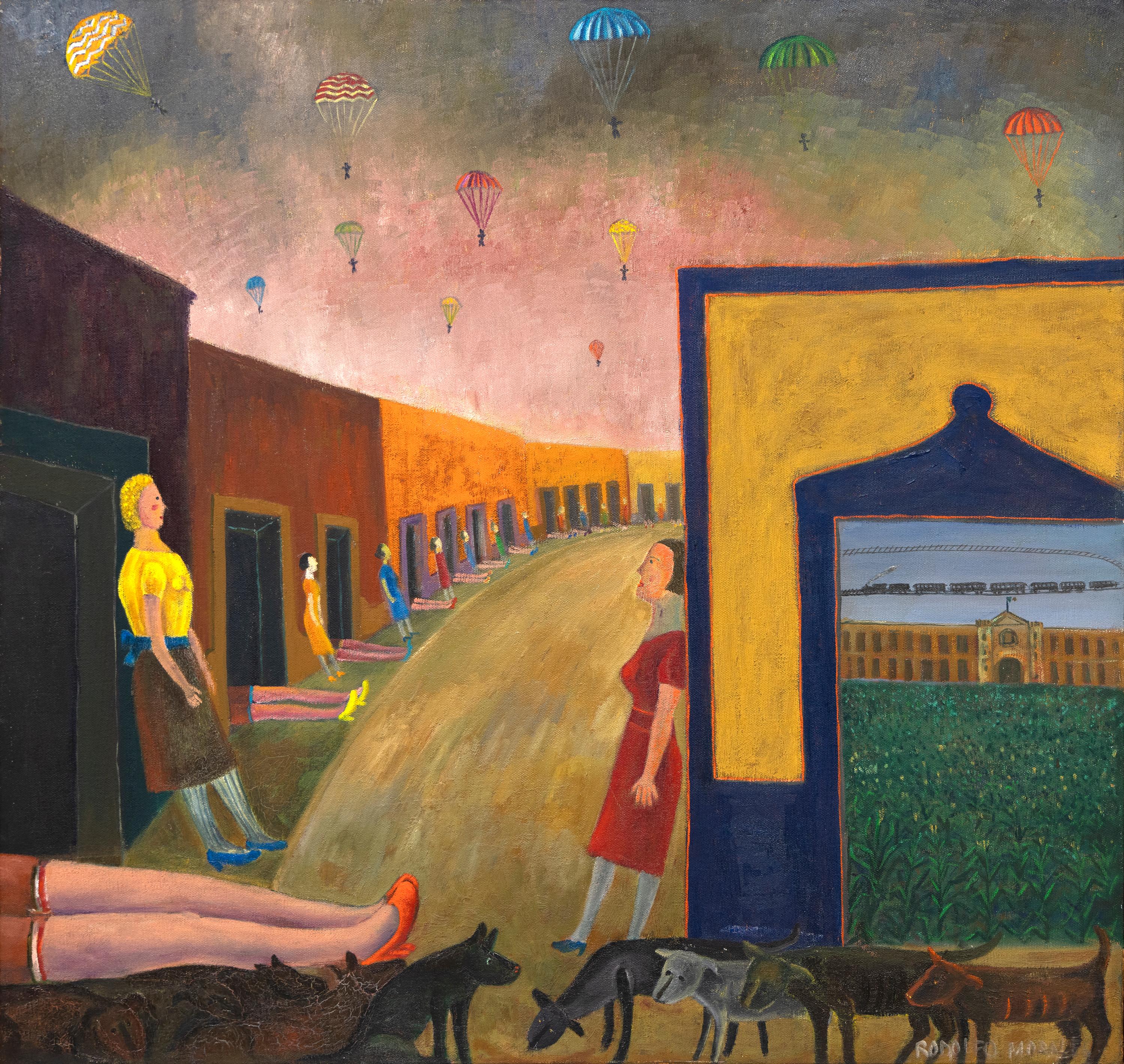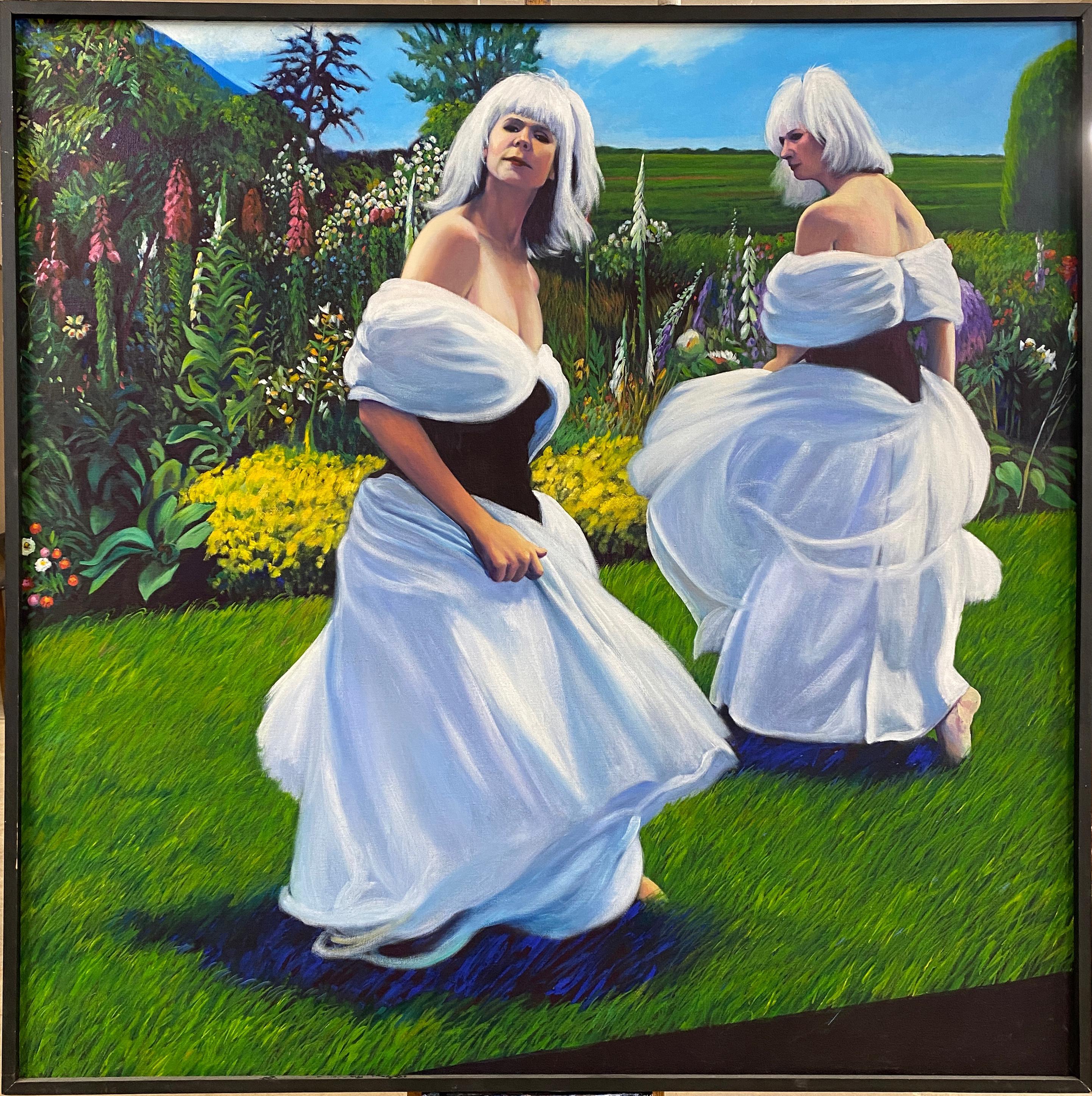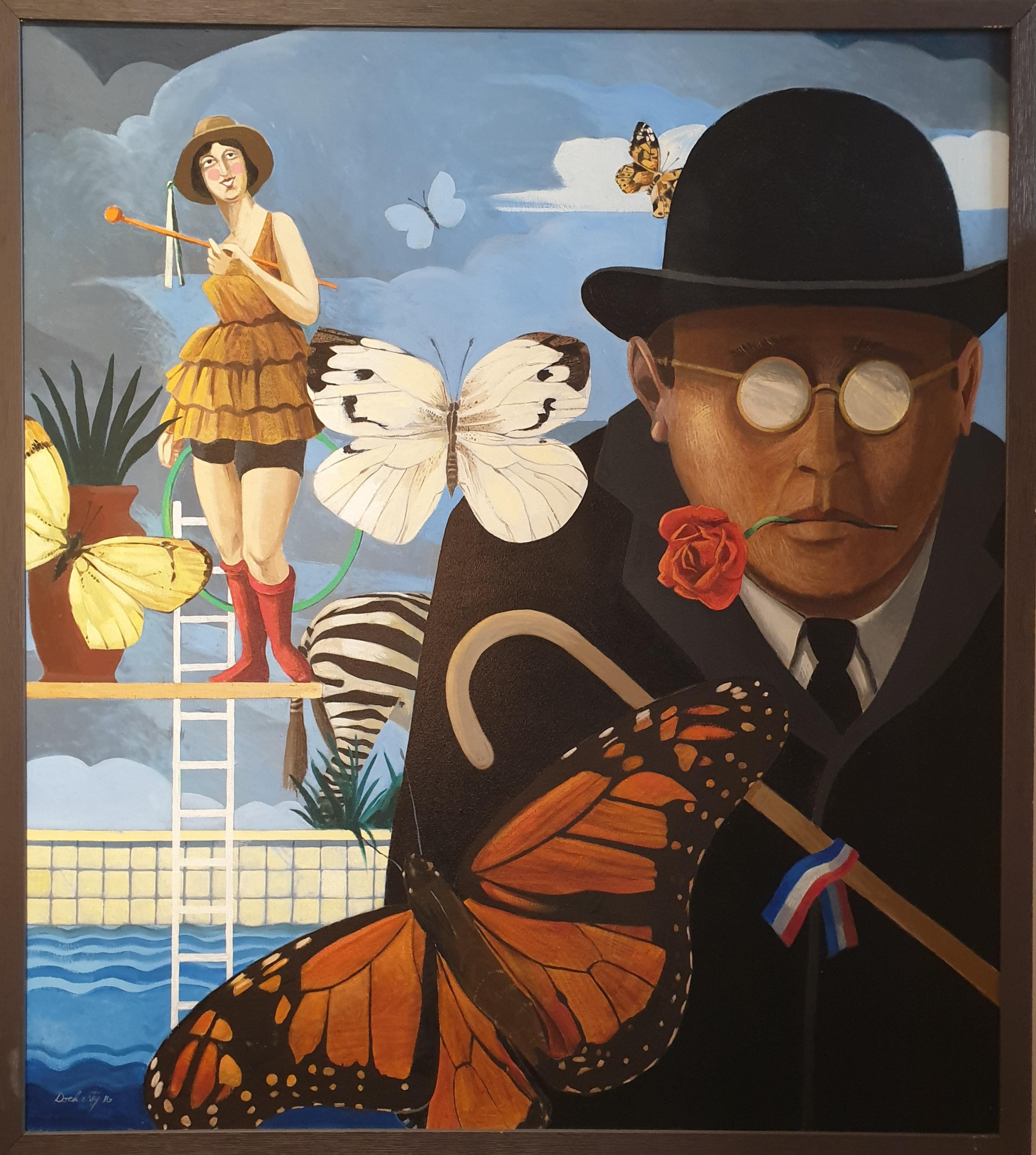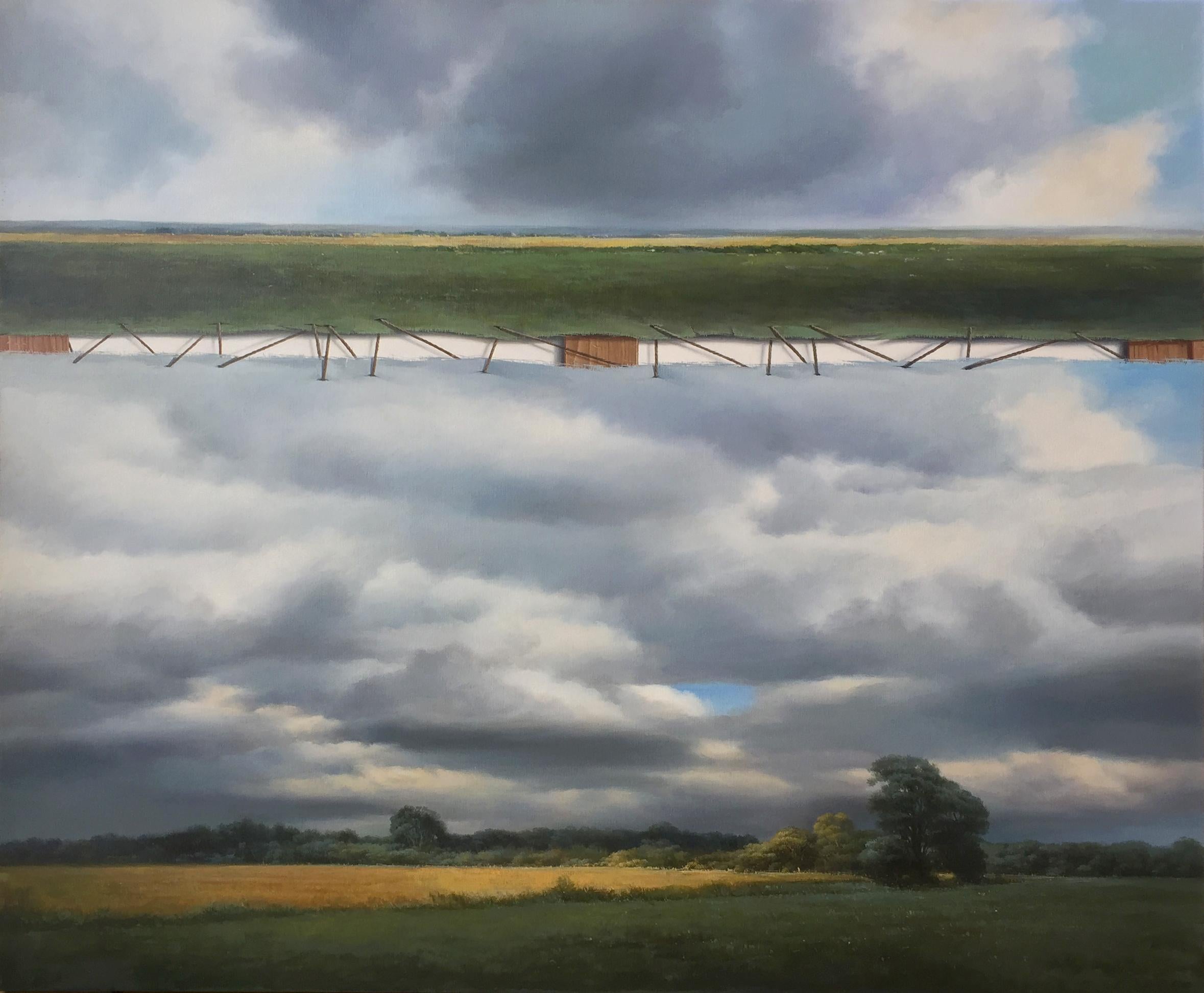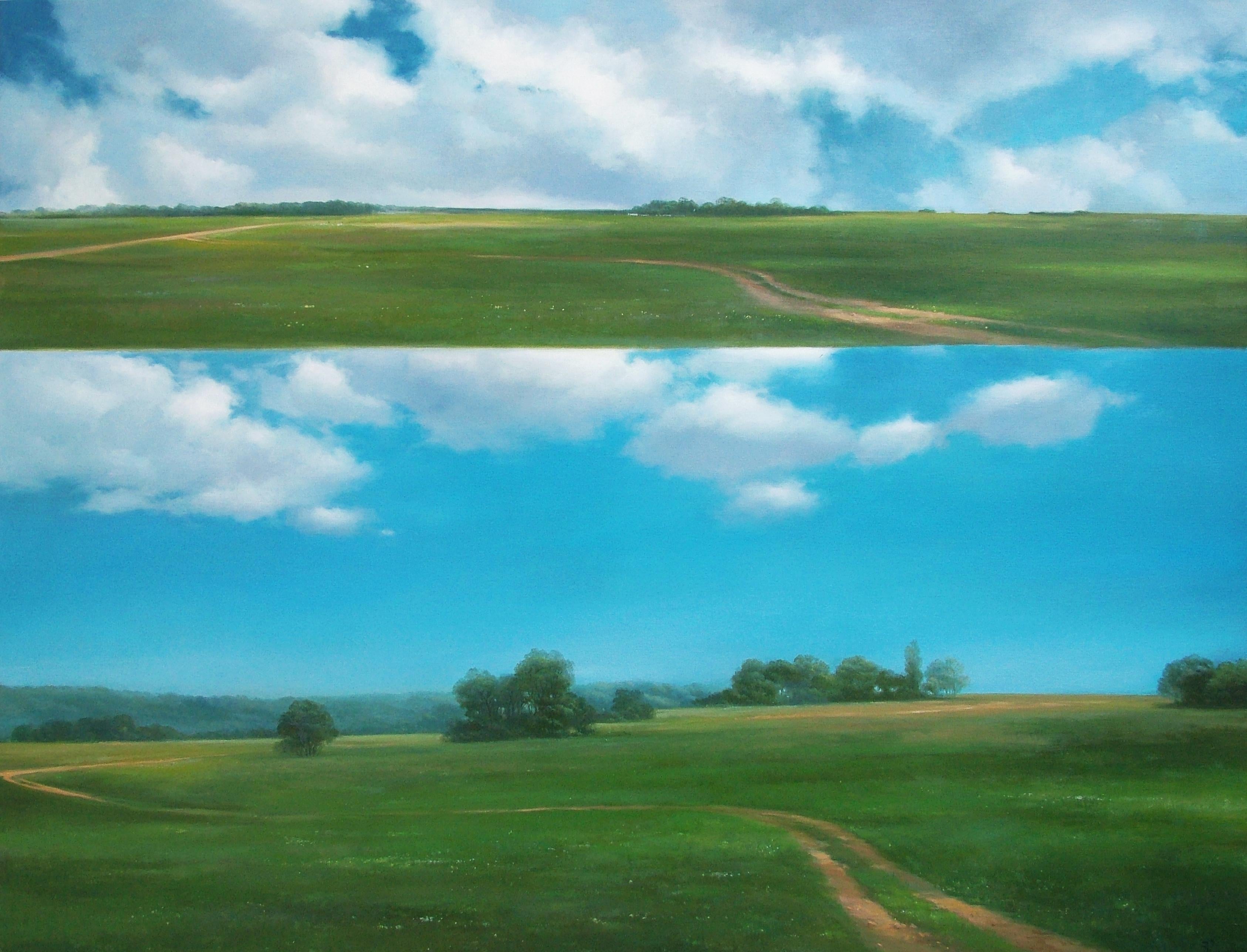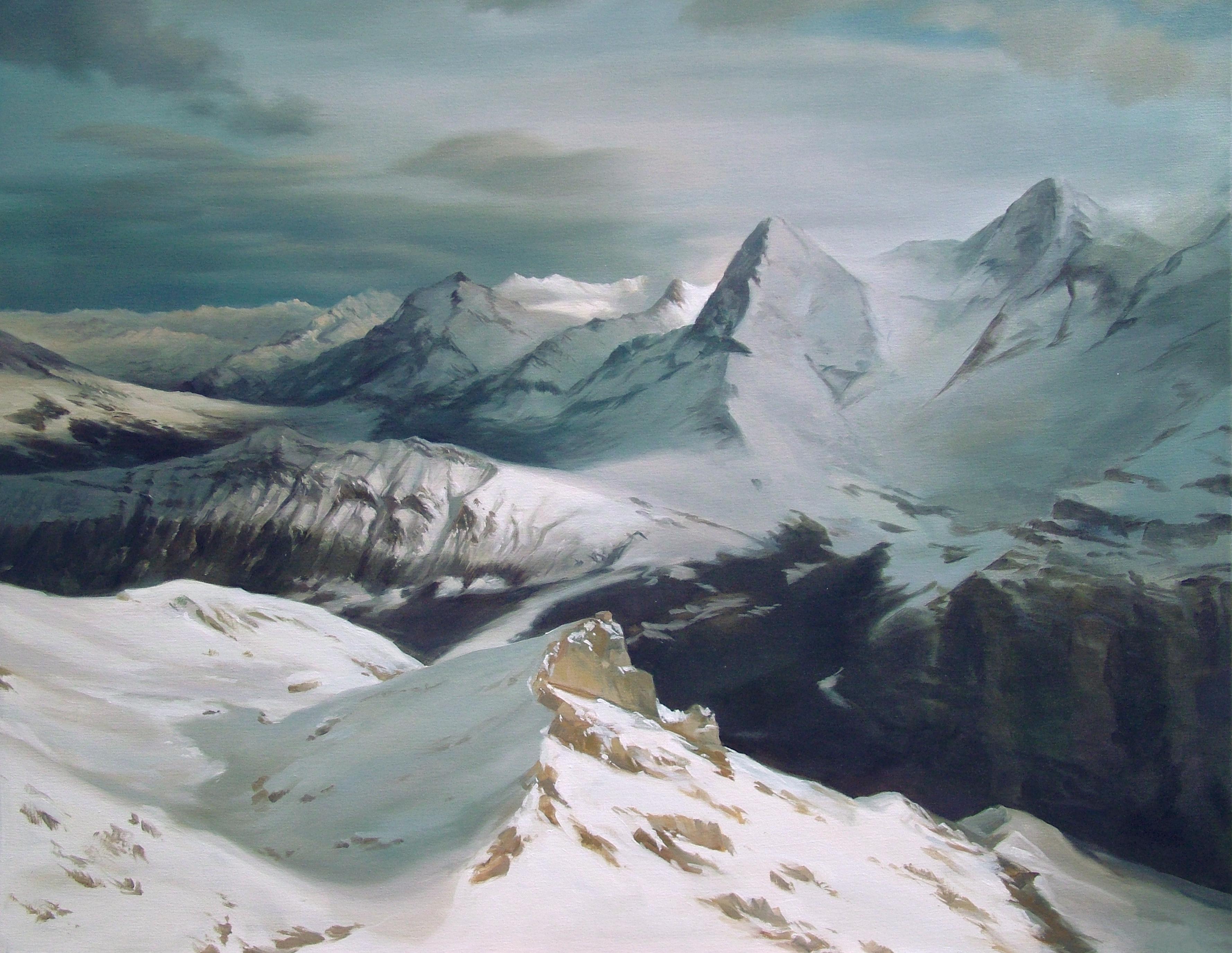Items Similar to Surrealist Very Large Late 20th Century Oil on Canvas. 'The Temple'.
Video Loading
Want more images or videos?
Request additional images or videos from the seller
1 of 22
Derek Carruthers Surrealist Very Large Late 20th Century Oil on Canvas. 'The Temple'.
About the Item
Very large Late 20th century surrealist oil on canvas by British artist Derek Carruthers. The painting is signed to the bottom right.
An imposing and highly colourful painting of colossal classical temples stacked in a totemic fashion encasing a naked heroic Graeco-Roman figure.
This painting is powerful and heroic in its representation. However, the temples are stacked shakily one on top of the other held together or constrained by scarlet red ropes. And within all this a human figure is encased or trapped, unable to barely move. The background of hills and trees is calm and inviting and although the sky is a deep blue with billowing white clouds a warning of ominous dark rainclouds appear to the right.
Carruthers often loved to use strong imagery to make a social comment. Do we enslave ourselves through dogma and organised religion? Does the individual in us become trapped and frozen by our self imposed rules and ideals? Are the ropes that bind the image here blood red to hint at the blood spilled over and over throughout history in the name of religion? Have we captured and enslaved God on earth to our ideals?
Carruthers likes to challenge our human perspective of what is normal. Using his constructivist approach to interlink art and architecture he takes images out of context or changes their relationship to each other either by manipulating size, juxtaposing images from different periods of time or by contrasting a beautiful background with its political or social meaning.
Derek Carruthers was an artist who persisted in asking questions. His whole career was inspired by the determination to enquire into the nature of art, examine its purpose, and attempt to explore that place where the individual life of the mind meets the external appearance of the world where personal sensation rubs up against cultural assumptions. Not surprisingly, Carruthers explored, over the years, a language of pure form, abstract space, 2 and 3 dimensions, narrative and concept, personal and universal figuration. Looking back, over decades of work, however, each of these voices is pursuing a coherent set of questions, reflecting on the stuff of human experience. Carruthuers’ individual pieces can intrigue and charm, they can be warm and poetic and they can also offer gritty resistance to the easy gaze. They can challenge us to think about ourselves, our environment, our expectations, our place in the world.
Carruthers grew up in the north-west of England having been born in Penrith, and one of his earliest memories of what art might be was formed by his encounter with the extraordinary creations of Kurt Schwitters. The latter had fled Germany in 1937, after his art had been labelled ‘degenerate’. He stayed, first, in Norway and then arrived in Britain in 1940. Carruthers had already encountered Schwitters' work as a boy, and had been launched on his own life-long examination of the nature of art.
Carruthers was further inspired by Victor Pasmore and Hamilton (British Constructivists) who were working closely together at King’s College London and eventually offered a challenging course to all first year students. Thus, Carruthers – who was at King’s in 1953 to 1957 was encouraged to take a rigorous approach to probing abstraction, spatial relationships, and the interlinking of art and architecture.
Having had the good fortune to have been an art student at such a time and in such a place, it is not surprising that Carruthers embarked on a voyage of artistic discovery. He showed his works with the major touring exhibition, organised by the Arts Council, in 1963, ‘Construction England’, together with Pasmore and Mary and Kenneth Martin.
His work was also included in exhibitions of new art at the Drian Galleries, Porchester Place, in 1963 to 1965. Reflecting the more recent re-examination of post-War, British Constructivism, Carruthers’ work was also included in the 1992 show, ‘British Abstract Art of the 50s and 60s’, held at the Belgrave Gallery. This early work, in which solid or relief forms change their nature as they – or the viewers – move through space and time, deliberately challenges the human tendency to find comfort in regarding the world as fixed and knowable.
In these years, too, Carruthers taught at Sunderland and Leicester Colleges of Art, before moving to lead the Fine Art course, as a Professor, at Trent Polytechnic (now the Nottingham Trent University). He was a dedicated educator, leaving to pursue his own art, full time, only in the mid 1980s.
Inspired, perhaps, by this freedom, the 1980s saw Carruthers exploring new ideas. He turned from working in 3-dimensions, or collage and relief, and rediscovered the power of traditional materials, oil and watercolour, on canvas and paper. He moved away from Non-Objectivity towards a practice which explored both abstracted and figurative imagery. Throughout, he remained preoccupied with exploring the human condition: by this trite remark, we mean that he continued to question how each individual experiences the world; he explored the ways in which human beings create totems to make their mark, as if to claim immortality; he tries to, ‘symbolise the triangular relationship between humankind and religion and the art / architecture which it inspires’. Hence - as well as warm glimpses of holidays and home life - his work yields the Egyptian pyramid, the Graeco-Roman heroic figure, the Christian monument; and, ultimately, the ‘sexless, ageless, raceless anonymity’ of the artist’s lay figure.
Derek Carruthers continued to ask questions, both about his life in a particular time and place, and about the lot of the human being on a universal scale. As an artist and a scholar, he saw himself at the intersection of these challenging states. And he makes you think........
- Creator:Derek Carruthers
- Dimensions:Height: 77.96 in (198 cm)Width: 53.94 in (137 cm)Depth: 0.79 in (2 cm)
- Medium:
- Movement & Style:
- Period:
- Condition:
- Gallery Location:Cotignac, FR
- Reference Number:
About the Seller
5.0
Platinum Seller
These expertly vetted sellers are 1stDibs' most experienced sellers and are rated highest by our customers.
Established in 2000
1stDibs seller since 2020
171 sales on 1stDibs
Typical response time: 1 hour
- ShippingRetrieving quote...Ships From: Cotignac, France
- Return PolicyA return for this item may be initiated within 3 days of delivery.
More From This SellerView All
- Large Surrealist Oil on Canvas. 'She brought Colour into his Life'.By Frank DochertyLocated in Cotignac, FRLarge surrealist contemporary oil on canvas by Scottish artist Frank McLean Docherty R.S.W, signed and dated bottom left and signed and titled 'She brought Colour into his Life' to the reverse. This piece whilst wonderfully colourful, playful and erotic is typical of the witty sense of humour this artist displays in all his work. Docherty likes to tease us visually and asks questions and presents conundrums to the viewer. Frank McLean Docherty was born in Glasgow , Scotland in 1942. He became a student at Glasgow School of Art in 1960 and graduated from the Department of Printed Textiles in 1964. He taught in a secondary school in the East End of Glasgow for two years, thereafter departing to work in Dublin in the Republic of Ireland as a textile designer (Marks & Spencer, Heals and Liberty of London). He was also an illustrator for a range of newspapers and an Art Director of magazines. In 1973, he was appointed Principal Teacher of Art in a Scottish High School and in 1978 was honoured by the Queen when he was appointed Member of the Royal Society of Painters in Watercolours (R.S.W.) He left education in 1994. Since that time he has developed a vision which is quite unique in Scottish Art. Bank Managers, toucans, lighthouses, penguins, bowler hats, Frank Docherty...Category
21st Century and Contemporary Surrealist Landscape Paintings
MaterialsCanvas, Oil
- A Very Bad Seagull, Contemporary Oil and acrylic on CanvasLocated in Cotignac, FRSurrealist contemporary oil and acrylic on canvas by Scottish artist Frank McLean Docherty R.S.W, signed and dated bottom left and signed and titled 'A Ve...Category
2010s Surrealist Figurative Paintings
MaterialsCanvas, Oil, Acrylic
- War and Peace, Mid-Century Surrealist Oil on Board.Located in Cotignac, FRMid-century Surrealist oil on board depicting War and Peace by Belgian Artist, Willy Smitz. Signed and dated bottom right with his recognisable triangular motif ( initialed WS ), in ...Category
Mid-20th Century Surrealist Landscape Paintings
MaterialsOil, Board
- Réalisme Fantastique, L'Etabli, The Work Bench, Mid Century Fantasy SurrealistLocated in Cotignac, FRFrench, réalisme fantastique, Surrealist oil on board by Claude Verlinde. Signed and dated bottom left. Presented in plain wood frame with gilt filet. ...Category
1950s Surrealist Figurative Paintings
MaterialsPanel, Oil
- Surrealist Gouache and Watercolour on Paper, The Three GracesLocated in Cotignac, FRLate 20th century surrealist gouache and watercolour on paper of The Three Graces by British artist Derek Carruthers. The painting is signed to the bottom right. An imposing and hig...Category
Late 20th Century Surrealist Figurative Paintings
MaterialsWatercolor, Paper, Gouache
- Surrealist Gouache on Paper, 'Threshold or Pagans'.Located in Cotignac, FRContemporary surrealist watercolour and gouache on paper by British artist Derek Carruthers. Signed bottom right. An intriguing and beautifully pain...Category
21st Century and Contemporary Surrealist Landscape Paintings
MaterialsPaper, Gouache
You May Also Like
- UntitledLocated in Palm Desert, CA"Untitled" is a painting by Rodolfo Morales. The painting is signed lower right, "Rodolfo Morales". The framed piece measures 37 3/4 x 39 7/8 x 2 1/4 in. Rodolfo Morales was a Mexican painter...Category
1980s Surrealist Figurative Paintings
MaterialsOil, Canvas
- 'Once Upon a Time, ' by George Oswalt, Oil on Canvas PaintingLocated in Oklahoma City, OKThis contemporary doppelgänger fairytale by George Oswalt features an aging prom queen in her black and white silk duponi dress dancing in an autumn fie...Category
Early 2000s Surrealist Figurative Paintings
MaterialsCanvas, Oil
- STORM, Oil on CanvasLocated in Montreux, CHKaren Shahverdyan „Storm“ 90 X 110cm, oil on canvasCategory
Early 2000s Surrealist Landscape Paintings
MaterialsCanvas, Oil
- SPRING UP, Oil on CanvasLocated in Montreux, CHKaren Shahverdyan „Eleven“ 129 X 147cm, oil on canvasCategory
Early 2000s Surrealist Landscape Paintings
MaterialsCanvas, Oil
- MOUNTAINS, Oil on CanvasLocated in Montreux, CHKaren Shahverdyan „Mountains“ 80 X 100cm, oil on canvasCategory
Early 2000s Surrealist Landscape Paintings
MaterialsCanvas, Oil
- WINTER BALANCE, Oil on CanvasLocated in Montreux, CHKaren Shahverdyan „Winter balance“ 90 X 110cm, oil on canvasCategory
Early 2000s Surrealist Landscape Paintings
MaterialsCanvas, Oil
Recently Viewed
View AllMore Ways To Browse
German Early 20th Century Painting
Large Scale Mid Century Art
Religion Vintage
Temple Pieces
Set Of 2 Paintings Oil Canvas
Oil Painting Roman Landscape
Very Large Early 20th Century Oil Painting
Vintage Roman Figural
Sky King
Egypt Temple
Landscape Oil Painting Egypt
Vintage Trap
Vintage Trapping
50s British Art
Pyramid Oil
Pyramid Oil Painting
Nottingham Paintings
Egypt Relief
